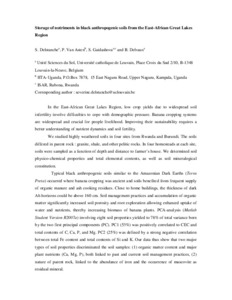| dc.contributor.author | Delstanche, S. |
| dc.contributor.author | Asten, Piet J.A. van |
| dc.contributor.author | Gaidashova, S.V. |
| dc.contributor.author | Delvaux, B. |
| dc.date.accessioned | 2019-12-04T11:19:43Z |
| dc.date.available | 2019-12-04T11:19:43Z |
| dc.date.issued | 2008 |
| dc.identifier.citation | Delstanche, S., Van Asten, P., Gaidashova, S. & Delvaux, B. (2008). Storage of nutriments in black anthropogenic soils from the East-African Great Lakes Region. Eurosoil Conference, Vienna, 25-29 August, 2008. P.1 |
| dc.identifier.uri | https://hdl.handle.net/20.500.12478/3517 |
| dc.description.abstract | In the East-African Great Lakes Region, low crop yields due to widespread soil infertility involve difficulties to cope with demographic pressure. Banana cropping systems are widespread and crucial for people livelihood. Improving their sustainability requires a better understanding of nutrient dynamics and soil fertility. We studied highly weathered soils in four sites from Rwanda and Burundi. The soils differed in parent rock: granite, shale, and other pelitic rocks. In four homesteads at each site, soils were sampled as a function of depth and distance to farmer’s house. We determined soil physico-chemical properties and total elemental contents, as well as soil mineralogical constitution.Typical black anthropogenic soils similar to the Amazonian Dark Earths (Terra Preta) occurred where banana cropping was ancient and soils benefited from frequent supply of organic manure and ash cooking residues. Close to home buildings, the thickness of dark Ah horizons could be above 160 cm. Soil management practices and accumulation of organic matter significantly increased soil porosity and root exploration allowing enhanced uptake of water and nutrients, thereby increasing biomass of banana plants. PCA-analysis (Matlab Student Version R2007a)involving eight soil properties yielded to 78% of total variance born by the two first principal components (PC). PC1 (53%) was positively correlated to CEC and total contents of C, Ca, P, and Mg. PC2 (25%) was defined by a strong negative correlation between total Fe content and total contents of Si and K. Our data thus show that two major types of soil properties discriminated the soil samples: (1) organic matter content and major plant nutrients (Ca, Mg, P), both linked to past and current soil management practices, (2) nature of parent rock, linked to the abundance of iron and the occurrence of muscovite as residual mineral. |
| dc.language.iso | en |
| dc.subject | Soil |
| dc.subject | Banana Cropping |
| dc.subject | Soil Management Practices |
| dc.subject | Organic Matter |
| dc.subject | Soil Fertility |
| dc.title | Storage of nutriments in black anthropogenic soils from the East-African Great Lakes Region |
| dc.type | Manuscript-unpublished |
| cg.contributor.affiliation | Université Catholique de Louvain |
| cg.contributor.affiliation | International Institute of Tropical Agriculture |
| cg.contributor.affiliation | International Society for Astrological Research |
| cg.coverage.region | Acp |
| cg.coverage.region | Africa |
| cg.coverage.region | Europe |
| cg.coverage.region | East Africa |
| cg.coverage.region | Central Africa |
| cg.coverage.country | Belgium |
| cg.coverage.country | Uganda |
| cg.coverage.country | Rwanda |
| cg.authorship.types | CGIAR and developing country institute |
| cg.iitasubject | Agronomy |
| cg.iitasubject | Soil Fertility |
| cg.iitasubject | Banana |
| cg.iitasubject | Soil Health |
| cg.iitasubject | Soil Surveys And Mapping |
| cg.iitasubject | Nutrition |
| cg.iitasubject | Integrated Soil Fertility Management |
| cg.iitasubject | Agribusiness |
| cg.iitasubject | Soil Information |
| cg.accessibilitystatus | Limited Access |
| local.dspaceid | 95488 |

